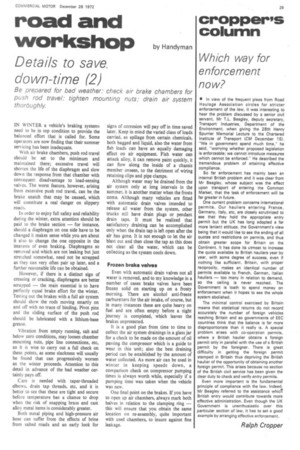road and workshop
Page 31

If you've noticed an error in this article please click here to report it so we can fix it.
by Handyman
Details to save.
down-time (2)
Be prepared for bad weather: check air brake chambers for push rod travel; tighten mounting nuts; drain air system thoroughly.
IN WINTER a vehicle's braking systems need to be in top condition to provide the balanced effort that is called for. Some operators are now finding that their summer servicing has been inadequate.
With air brake chambers, push rod travel should be set to the minimum and maintained there; excessive travel will shorten the life of the diaphragm and slow down the response from that chamber with consequent disadvantage to load-sensing valves. The worst feature, however, arising from excessive push rod travel, can be the brake snatch that may be caused, which will constitute a real danger on slippery roads.
In order to enjoy full safety and reliability during the winter, extra attention should be paid to the brake section — for instance, should a diaphragm on one side have to be changed it makes sense while you are about it also to change the one opposite in the interests of even braking. Diaphragms so removed and which are not leaking but just stretched somewhat, need not be scrapped as they can very often pair up later, and a further reasonable life can be obtained.
However, if there is a distinct sign of creasing or cracking, diaphragms are better scrapped — the main essential is to have perfectly equal brake effort for the winter. Testing out the brakes with a full air system should show the rods moving smartly on and off with no trace of binding. Pivot pins and the sliding surface of the push rod should be lubricated with a lithium-base grease.
Vibration from empty running, salt and below zero conditions, may loosen chamber mounting nuts, pipe line connections, etc, so it is wise to carry out a full check on these points, as some slackness will usually be found that can progressively worsen as the winter proceeds. Attention to this detail in advance of the bad weather certainly pays off.
Care is needed with taper-threaded elbows, drain tap threads, etc, and it is better to see that these are tight and secure before temperature has a chance to drop when the risk of snapping brass and cast alloy metal items is considerably greater.
Both metal piping and high-pressure air hose can suffer from the effects of brine from salted roads and an early look for signs of corrosion will pay off in time saved later. Keep in mind the varied class of loads carried, as spillage from certain chemicals, both bagged and liquid, also the water from fish loads can have an equally damaging effect on air equipment. Fish water can attack alloy, it can remove paint quickly, it can flow along the inside of a chassis member unseen, to the detriment of wiring retaining clips and pipe clamps.
Although water may be drained from the air system only at long intervals in the summer, it is another matter when the frosts come. Although many vehicles are fitted with automatic drain valves intended to release all water from the system, other trucks still have drain plugs or pendant drain taps. It must be realized that satisfactory draining can be accomplished only when the drain tap is left open after the air has gone. It is not enough to let the air blast out and then close the tap as this does not clear all the water, which can be collecting as the system cools down.
Frozen brake valves Even with automatic drain valves not all water is removed, and to my knowledge in a number of cases brake valves have been frozen solid on starting up on a frosty morning. There are alcohol anti-freeze carburetters for the air intake, of course, but in many instances these are quite heavy on fuel and are often empty before a night journey is completed, which leaves the brakes unprotected.
It is a good plan from time to time to collect the air system drainings in a glass jar for a check to be made on the amount of oil passing the compressor which is a guide to wear in this unit; also the best draining period can be established by the amount of water collected. As more air can be used in winter in keeping speeds down, a comparison check on compressor pumping times is always worth while, especially if a pumping time was taken when the vehicle was new.
One final point on the brakes. If you have to open up air chambers, always mark both halves in relation to the clamping ring — this will ensure that you obtain the same location on re-assembly, quite important with used chambers, to insure against fine leakage.












































































